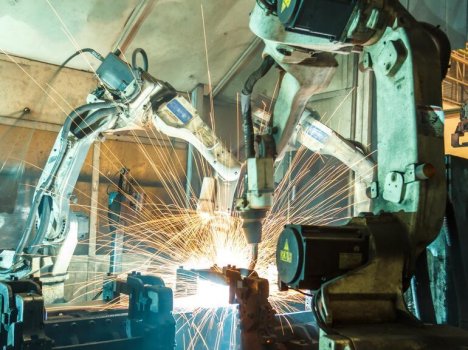K
Kathleen Martin
Guest
Closed-loop manufacturing is central to Manufacturing 4.0 automation, but it's also been in place on production floors for years. But can it be automated to work with little or no human intervention? Or should it be?
A closed-loop system on a production floor is a set of machines utilized in manufacturing that communicate and coordinate with each other to get certain processes done. The only catch is when something goes wrong and an alert is issued. At that point, a human has to step in to resolve the issue.
What the Manufacturing 4.0 (also known as Industry 4.0) movement hopes to achieve is total automation of these closed-loop systems. It proposes to do this by using artificial intelligence and machine learning in an overarching manufacturing operating system that runs each closed-loop system deployed on the floor.
Binghampton University Professor Sang Won Yoon explained this in detail: "With the rapid technology development, such as the Industrial Internet of Things, big data analysis, cloud computing, artificial intelligence, many manufacturing processes can be more intelligent, and Industry 4.0 can then be realized in the near future … . Data-driven solutions, such as AI and machine-learning algorithms, can be applied to diagnose abnormal defects and adjust optimal machine parameters in response to unexpected changes/situations during production. Smart manufacturing adopts real-time decision-making based on operational and inspectional data and integrates the entire manufacturing process as a 'unified framework.'"
This is the Manufacturing 4.0 vision for closed-loop systems—and it presents several interesting implications for edge computing.
1. AI-directed closed-loop systems can benefit edge deployments
Imagine a series of closed-loop systems distributed at the enterprise edge that can "run themselves" in a closed environment, much like a mini-network. This could reduce present resource stressors, like challenges in managing and paying for large data payloads that continuously stream over communications lines to data centers and clouds.
Instead, IoT data can be processed and stored locally within each closed-loop system. Outside communications loads and costs are reduced, with the exception of batched data and transactions that are required for centralized storage over time.
Closed-loop systems also provide additional resilience if a data center or cloud outage occurs because these systems can sustain themselves.
2. Edge architecture may need to be revisited
Current edge data collection and forwarding is orchestrated around clouds, data centers and the edge. With self-contained and fully automated closed-loop manufacturing, it would be likely that the volume of data transmissions and storage to and into the cloud or data center would be reduced, resulting in an edge architecture that becomes even more distributed in data processing and storage than it is today.
Continue reading: https://www.techrepublic.com/article/ai-in-closed-loop-manufacturing-can-benefit-edge-computing-systems-4-things-to-consider-in-iiot/
A closed-loop system on a production floor is a set of machines utilized in manufacturing that communicate and coordinate with each other to get certain processes done. The only catch is when something goes wrong and an alert is issued. At that point, a human has to step in to resolve the issue.
What the Manufacturing 4.0 (also known as Industry 4.0) movement hopes to achieve is total automation of these closed-loop systems. It proposes to do this by using artificial intelligence and machine learning in an overarching manufacturing operating system that runs each closed-loop system deployed on the floor.
Binghampton University Professor Sang Won Yoon explained this in detail: "With the rapid technology development, such as the Industrial Internet of Things, big data analysis, cloud computing, artificial intelligence, many manufacturing processes can be more intelligent, and Industry 4.0 can then be realized in the near future … . Data-driven solutions, such as AI and machine-learning algorithms, can be applied to diagnose abnormal defects and adjust optimal machine parameters in response to unexpected changes/situations during production. Smart manufacturing adopts real-time decision-making based on operational and inspectional data and integrates the entire manufacturing process as a 'unified framework.'"
This is the Manufacturing 4.0 vision for closed-loop systems—and it presents several interesting implications for edge computing.
1. AI-directed closed-loop systems can benefit edge deployments
Imagine a series of closed-loop systems distributed at the enterprise edge that can "run themselves" in a closed environment, much like a mini-network. This could reduce present resource stressors, like challenges in managing and paying for large data payloads that continuously stream over communications lines to data centers and clouds.
Instead, IoT data can be processed and stored locally within each closed-loop system. Outside communications loads and costs are reduced, with the exception of batched data and transactions that are required for centralized storage over time.
Closed-loop systems also provide additional resilience if a data center or cloud outage occurs because these systems can sustain themselves.
2. Edge architecture may need to be revisited
Current edge data collection and forwarding is orchestrated around clouds, data centers and the edge. With self-contained and fully automated closed-loop manufacturing, it would be likely that the volume of data transmissions and storage to and into the cloud or data center would be reduced, resulting in an edge architecture that becomes even more distributed in data processing and storage than it is today.
Continue reading: https://www.techrepublic.com/article/ai-in-closed-loop-manufacturing-can-benefit-edge-computing-systems-4-things-to-consider-in-iiot/

